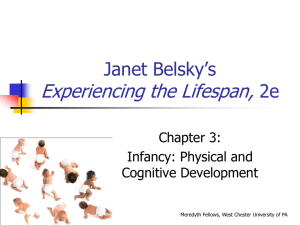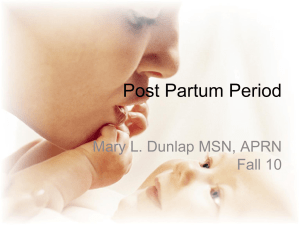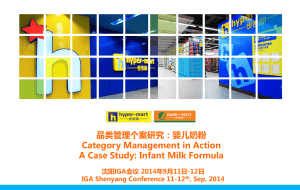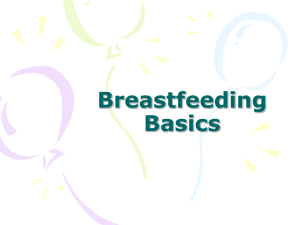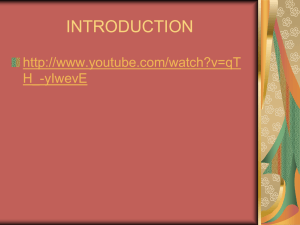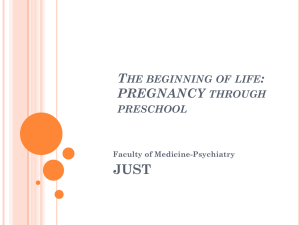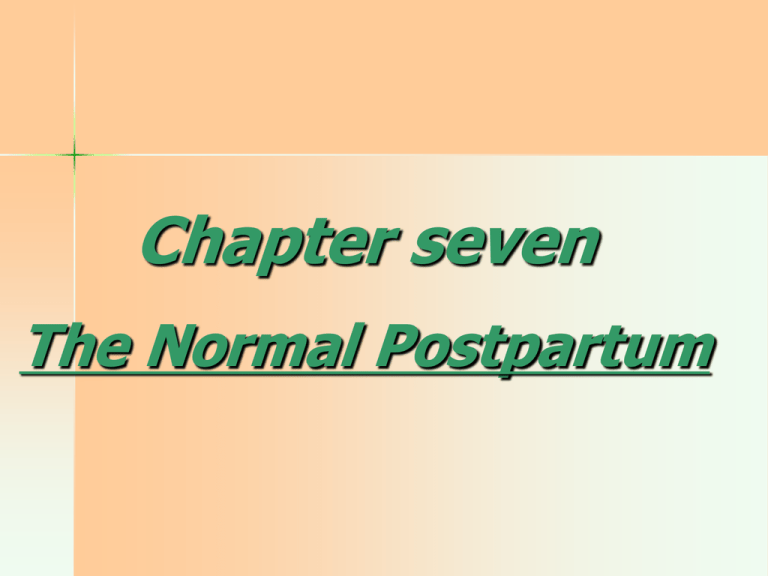
Chapter seven
The Normal Postpartum
Normal Post Partum
Definition
The postpartum period is the
period of time following the
delivery of the child during which
the body tissues, especially the
reproductive system reverts back
to the pre-pregnant state, both
anatomically and physiologically.
Duration of the
postpartum period is
40 days or 6-8 weeks
(maximum involution).
Another 4 to 6 weeks is
needed for complete
involution.
It is divided into three
phases:
Immediate
Postpartum: the
24-hour period immediately
following delivery.
Early Postpartum or
puerperium: up to 7 days.
Remote
postpartum or
puerperium: up to 6 weeks.
The puerperal period is much
shorter after abortion. The
first ten days are called the
early postpartum, and the
days after are called the late
postpartum.
Physiological Changes
during Postpartum
General Physiological Changes
The woman in labor goes through a
tremendous amount of stress and
strain. And it takes some time for her
general condition to settle down to a
normal state again.
Immediately following labor the general
condition of the mother is one of
physical fatigue.
Vital Signs
Temperature:
The
temperature is slightly
elevated: 0.5 degrees for the
first 24 hours and up to 38
degrees is known. This rise in
temperature is due to the
absorption of waste products
of muscular contractions of
labor.
Transient
rise in
temperature later on is
due to:
• Milk engorgement (by
the 4th day postpartum).
• Constipation.
• Nervous excitation.
• Infection.
The
pulse:
The
pulse is full and slow (about
60-70 B/mm) and is known as
physiological bradycardia (for 2448 hrs after labor). It is due to:
• The rest period after labor .
• The increase in the circulating
blood volume on account of the
elimination of the placental pool.
The
pulse should remain
below 100 B/mm if all is
going well. A rapid pulse
may be brought on by
pain, visitors, excitement,
exhaustion, the nursing
infant, hemorrhage or
infection.
Respiration:
This
is in the usual relation with
pulse and temperature. Because
of a reduction in the size of the
uterus and relaxation of the
abdominal wall respiration is
more abdominal in character.
Deviation from the normal may
suggest pneumonia or
embolism.
Blood
No
Pressure:
change is counted, but
if hypotension is present,
postpartum hemorrhage
may be suspected. If
hypertension is present
(over 140/90 mm Hg)
postpartum toxemia may
be suspected.
Skin
Excessive sweating (diaphoresis),
particularly in patients who were
subjected to edema in late
pregnancy, in order to get rid of
excess fluids that were retained in
the tissues. This gradually ceases
within the 1st week and the skin
reacts as usual.
Skin pigmentation gradually
disappears.
Kidneys and Urinary Output
There is usually physiological
diuresis (polyuria).
Painful, difficult micturition due to
tears, lacerations or episiotomy
may result in reflex retention of
urine.
Traces of albumin and peptone
may be present as a result of
muscle involution.
Lactosuria is common with milk
engorgement on the 4th day at
the start of lactation.
•
•
•
•
•
The parturient may experience
some retention of urine in the first
few days after labor due to:
Laxity of the abdominal muscles.
Inability to micturate in the
recumbent position.
Reflex inhibition due to stitched
perineum or bruised urethera.
Atony of the bladder.
Compression of the urethra by
edema or hematoma
Bowel Function and
Intestinal Elimination
Thirst
is present due to
the marked fluid loss
through sweat and urine.
Tendency to atony of the
gastrointestinal tract,
with flatulence and
constipation.
Constipation may be present
as a result of:
Intestinal atony.
Anorexia after labor.
Loss of body fluids.
Laxity of the abdominal wall.
Hemorrhoids.
Reflex inhibition.
Enema in labor.
Blood Picture
slight decrease in total blood volume
due to dehydration and blood loss.
This comes back to normal in 7 days.
With proper antenatal care, the
amount of blood loss during the 3rd
stage of labor does not cause
anemia.
Blood volume decreases, Hb% also
diminishes, but not proportionately,
hydremia of pregnancy disappears
and stabilizes by the 5th day.
A moderate increase at around the
4th to the 10th day after delivery in
the leucocytic count, fibrinogen and
sedimentation rate occurs during the
first then gradually gets back to
normal values.
In the absence of complications and
with proper diet and hygiene, RBC
count and content, and the blood
constituents, usually return to the
non-pregnant levels in 4-6 weeks.
Body Weight
A weight loss of about 4.0 Kg takes
place at the time of delivery of the
baby, placenta, membranes and liquor
amnii. A further loss of about 3Kg
takes place during the puerperium due
to the elimination of water and
decreased size of the uterus.
So, in a woman with a standard
weight gain of 10Kg during pregnancy,
there is a weight loss of 7 Kgs after
delivery. She will thus have a net
weight gain of 3Kg due to pregnancy.
After-pains
It is a spasmodic colicky pain in the
lower abdomen (like menstrual pain
that come and go) during the early
postpartum days due to the vigorous
contractions of the uterus.
It is more common and more severe
in multiparas (due to weak muscle
tone), multiple pregnancy,
polyhydraminius, large-sized infant in
diabetic mothers (increase intra
abdominal pressure).
After-pains can be precipitated
by the presence of blood clots, a
piece of membrane, or placental
tissue.
After-pains increase during
breastfeeding the infant because
the infant’s sucking stimulates
further milk production, which in
turn stimulates the posterior
pituitary gland to secrete
oxytocin that results in more
uterine contractions, causing
increase in after-pains.
Return of Menstruation
Non-lactating mothers begin to
menstruate again in 6-8 weeks. It
may be delayed for a longer period
without any abnormal condition
being present.
In lactating mothers, menstruation
usually reappears not earlier than
4-5 months, and sometimes as late
as 24 months.
The
first period is generally
profuse and prolonged.
It
should be mentioned
that ovulation can
commence in the absence
of menstruation, and
another pregnancy can
occur.
Specific Anatomical
Changes
Uterus:
Involution of the uterus is the return of
the uterus to its pre-pregnant
condition.
Size
of the uterus: Immediately
after labor the level of fundal
height should be at or below the
level of the umbilicus. The uterus
should be firm, well contracted
and in the midline. It decreases in
size daily, and the level of the
fundus descends gradually at a
rate of about 1 finger breadth
every day, i.e.,
by the end of 1st week the
fundus is midway between
umbilicus and symphysis
pubis. By the 2nd week the
fundus is just behind the
symphsis pubis, and
thereafter, it becomes a
pelvic organ that can no
longer be felt abdominally.
Weight:
The weight of the uterus also
decreases gradually throughout the
postpartum. By the end of the
Postpartum it weighs 50 gm instead of
1000 gm during pregnancy. The
involution of the uterus is
accomplished through two
mechanisms or processes.
Inside the uterus, the site of
attachment of the placenta becomes a
small, raised, reddish region of only
around 7 - 8 cms in diameter
Autolysis (Self Digestion)
The
protein material of the
muscle fibers is broken
down by certain enzymes
and absorbed in the blood
stream, and excreted by
the kidneys in the urine.
lschemia (Decreased Blood Supply)
Contraction and retraction of the
uterine muscle fibers compresses
the blood vessels and reduces the
blood supply to the uterus. The old
blood vessels become obliterated
by thrombosis, and then undergo
degenerative changes. The remains
of blood vessels can be detected as
elastic fibers in the multiparous
uterus.
A process known as exfoliation
also occurs at this time.
Exfoliation is the sloughing off of
dead tissue at the site where the
placenta attached to the uterine
wall. Exfoliation leaves the site
smooth and without scar tissue
to allow for the implantation of
fertilized ova in subsequent
pregnancies.
In the Endometrium
Separation
of the placenta and
membranes occur in the deeper
portion of the spongy layer of
the decidua. All but the basal
layer is shed off in the lochia. A
new endometrium is formed in
the next weeks except at the
placental site, which is a raised
area of thrombotic sinuses.
This area is finally healed and
covered by a new
endometrium by the end of
7th week approximately (40
days).
If the process of involution is
slow, or delayed, the
condition is known as
“subinvolution”, while rapid
involution of the uterus is
called “hyperinvolution”.
Lochia:
It is the uterine discharge coming
through the vagina during the first 3-4
weeks of the postpartum. It is alkaline
in reaction, the amount is rather more
than the menstrual flow, with fleshy
odor. It contains blood, fibrin,
leucocytes, dead decidual tissue,
vaginal epithelial cells, peptone,
cholesterol, and numerous
nonpathogenic bacteria.
There are three types:
Lochia Rubra: the discharge is dark
red, bloody, fleshy, musty, stale nonoffensive odor; clots in color due to
the presence of a fair amount of
blood, shreds of the deciduas, large
amount of chorion, amniotic fluid,
lanugo hair, vernix caseosa, and
meconium may also be present. This
discharge lasts from the 1st
postpartum day, to the 4th day (and
sometimes to 7th day).
Lochia
serosa: pink, or
brownish; watery; odorless
discharge containing less blood
and more serum, and extends
for another 3 to 4 days.
Lochia alba: a creamy or white
colored discharge containing
leucocytes and mucus. It
remains for the 10th day
postpartum.
Clinical significance of abnormal
lochia:
Fetid lochia denotes the presence of
infection and/or stagnation.
Sudden suppression may be due to
severe infection.
Prolongation or recurrence of lochia
rubra may suggest retained parts of
the placenta, membranes, RVF,
subinvolution, tumors, as fibromyom
or chorion epithelium.
Genital Organs
Vagina:
The vagina diminishes in size, but not as the
pre gravid state. Rugea reappears in the
third week. These are small skin folds in the
lower part of the vaginal wall, dark red in
color.
• The anterior and posterior vaginal walls may
be sagging immediately after labor and for a
few days after. If early ambulation,
accompanied by heavy household duties, is
allowed, cystocele, rectocele or uterine
prolapse, may develop. Rest in bed, elevation
and tightening exercises prevent these
lesions.
Cervix: The cervix or the mouth
of the uterus contracts less
slowly than the uterus.
Immediately after delivery it
becomes an opening of about 2 3 cm in diameter with flabby,
irregular edges. But at the end of
7 days, the cervical opening
becomes much narrower and can
admit just the tip of a finger
Vulva:
Edema, minute or frank lacerations,
may be seen immediately after labor.
Edema disappears gradually in a few
days while lacerations, if not properly
mended by sutures, may lead to the
formation of a postpartum ulcer which
is a septic very tender ulcer with a
grayish necrotic film covering its
surface.
The vulva tends to gap for some time
after delivery.
Ligaments and Other
Structures
The ligaments that support the
uterus, ovaries and the tubes,
which have also undergone great
tension and stretching, are now
relaxed and will take a
considerable time to return to
their almost normal size and
position.
Other
structures such as the
peritoneum, pelvic floor
muscles and parametrium
involute near to their
original state, but some
relaxation may persist,
especially in the pelvic floor
muscles and parametrium.
The Abdominal Wall
The
muscles that were over
stretched during pregnancy,
and strained during labor, are
slow to regain their normal
tone and elasticity. The recti
muscles may separate widely
so that the uterus may be felt
between them.
Sometimes other viscera may
also protrude when the
mother sits or stands; this
condition is known as
diastasis recti. Diastasis recti
is an abnormal condition
during postpartum in which
there is laxity and separation
of the recti muscles.
Causes and predisposing
factors.
Over distention of the uterus, as
in multiple pregnancies,
polyhydraminous and large
babies, or by disproportion
between the infant and the
pelvis (the fetus fails to
descend, and a pendulous
abdomen develops).
Anatomy :
Breasts
The breasts are compound secreting
glands, composed of approximately 15-20
lobes arranged radially. Each lobe is
divided into lobules forming cavities called
alveoli lined with secretory cells that
produce milk. Five small lactiferous ducts,
carrying milk from alveoli of each lobe
unite to form 20 larger ducts. They widen
before opening on the surface of the nipple
to form ampullae or lactiferous sinuses that
act as temporary reservoirs for milk.
The nipple is composed of
erectile tissue containing plain
muscle fibers that have a
sphincter like action in
controlling the flow of milk. The
milk goes out of the nipple
through 8-15 small orifices.
The female breasts, also known
as the mammary glands, are
accessory organs of
reproduction.
Situation:
One breast is situated on each side of
the sternum and extends between
the second and sixth rib.
Types of nipples:
Normal or protruded.
Bifid or divided into two parts.
Flat at the level of the skin.
Depressed below the level of the
skin.
Physiology of Lactation
During
pregnancy estrogen
and progesterone secreted by
the placenta prepare the
breasts for lactation. The
estrogen inhibits milk
production until the end of
pregnancy. In the 3rd
trimester of pregnancy
colostrum is present and
remains for the first 3 days
postpartum.
By the 3rd stage of labor
(delivery of the placenta), the
hormonal production is reduced,
and during the next 48 hrs, the
blood level of estrogen and
progesterone fall. This
stimulates the anterior pituitary
gland to produce the lactogenic
hormone (prolactin hormone)
which acts on the acini cells in
the breast, and milk is formed.
The milk is pushed along the
lactiferous ducts and some is
stored in the ampullae which lie
just under the areola. When the
infant sucks, he takes the nipple
and the areola into his mouth,
and partly by a vacuum which is
created mostly by a chewing
action of his jaws, milk is pushed
into his mouth and he swallows.
As
the ampulla and lower
ducts are emptied, milk is
pushed from the alveoli
by contraction of the
myoepithelial cells. So,
the act of sucking by the
infant is the stimulus that
provokes lactation.
This effects a neuro-hormonal
reflex mechanism which
activates the anterior pituitary
lobe to produce lactotropin,
and the posterior pituitary lobe
to produce oxytocin which
reaches the breast through the
blood stream, leading to
contraction of myoepithelial
cells, and the expulsion of
milk.
Oxytocin also stimulates uterine
contractions causing after pains and
lochial discharge during
breastfeeding.
With the onset of milk the breasts
become larger firmer, heavier, and
full of milk that can be expressed on
pressure, or may escape
spontaneously. This procedure is
associated with a considerable local
throbbing pain extending the
axillae.
Characteristics
of breast
milk. It is suited to the
infant’s needs, easily
digestible, germ-free, fresh,
warm and contains
antibodies, vitamins, calcium,
lactose, casein protein, fat,
mineral salt and water. It is
also readily available, and
costs little.
Types of Breast milk
Breast milk at different stages of
lactation is defined by different
terms.
Colostrum: is a thick, sticky and light
yellowish in colour which is
produced during the first few days
after delivery. Although secreted in
small quantities (30-90ml), it is
sufficient to meet the caloric needs
of a normal newborn in the first few
days of life.
Transition milk :During a period
of 1-2 weeks that follow the
colostrum stage the milk
increases in quantity and
changes in appearance and
composition as per the baby's
needs, protein contents
decrease while fat and sugar
contents increase. This is the. At
this time the breasts feel full,
hard and heavy.
Mature milk: This milk is
thinner and watery but
contains all the nutrients
essential for optimum
physical and mental
development of the child.
Mature milk changes even
during the length of a single
feed to exactly suit the needs
of a baby.
The mature milk consists of
Foremilk and Hind milk:
Foremilk :The milk which
comes at the start of a feed. It
has a low level of fat and is
high in lactose, sugar, protein,
vitamins, mineral and water.
It satisfies the baby's thirst
and is produced in larger
amounts than hind milk.
Hind milk: which comes later in a
feed, is richer in fat which makes
it look whiter and thicker than
foremilk. It satisfies the babies
hunger and supplies much of the
energy of a breastfeed. It should
be noted that a baby needs both
the foremilk and the hind milk for
appropriate weight gain. Also,
babies who are fed both foremilk
and hind milk sleep well.
Preterm milk: is a milk produced
by a woman who has delivered
prematurely. This milk has more
proteins, minerals, immunoglobulin
and lactoferrin than the mature
milk, making it suitable for the
needs of a preterm baby. The
preterm milk is ideal food for low
birth weight babies. Term milk is
produced by a woman who has a full
term delivery. Its composition is
suitable for normal term baby
Breast feeding in the correct position
Art and technique of breast feeding
Step 1:
Find a comfortable
position for your self.
You may lie down; sit
on a chair on the bed
or on the floor to feed
your baby. Most
important is that you
must feel comfortable
and your back must
be supported
Step 2:
Hold your baby in
your arm so that
her head and neck
rest in the bend of
their elbow , the
back along forearm
and the buttocks in
your hands if your
feeding on your
right breast your
right arm should be
used to cradle your
baby.
Step 3:
Turn the baby's entire
body towards yours so
that the baby's tummy
touches your tummy.
The babies head and
neck should be
supported
Step 4:
Raise the baby to the level of
your breast so that the
babies mouth can easily
reach the nipple and the
areola. This could be made
possible by putting a pillow
below your arm or raising
your thigh if your sitting
crossed leg on the floor.
Make sure that the baby is not
exclusively clothed so that the
baby can be brought really close
to you. Some times you may
need to tuck your babies arm
away. So that it does not come
in the way. You may use your
free hand to hold your breast or
to fondle your baby once your
baby is really attached.
Step 5:
When the nipple touches, the
baby's lips or the cheek, your
baby's mouth will reflexively
open to draw the nipple and part
of the areola in to form a teat.
this is known as "attachment to
the breast" the lactiferous
sinuses which are the
storehouses of milk are situated
beneath the areola.
To effectively suckle milk from the
breast, both the nipple and the
areola should go into the baby's
mouth. Proper attachment is the
key to successful breast feeding,
improper attachment is
responsible for most of the
problems related to breast
feeding like sore nipple,
congested breast and inadequate
milk supply
Body
position: The mother
should feed her baby in
any comfortable position
such as lying or sitting
with good eye contact.
Good and bad body
positions are shown in Fig.
a & b.
A
B
Pic . a: Good body position
Baby’s head and neck is
straight or bend slightly back.
Baby’s body is turned towards
the mother.
Baby’s body is close to the
mother facing breast.
Baby’s whole body is
supported.
Mother baby eye contact is there
Pic . b: Bad body position
Baby’s head and neck not
straight.
Baby’s body is turned away from
the mother.
Baby’s body is away from the
mother.
Baby’s body is not supported.
There is no eye contact between
the mother and baby
''Good attachment ''latch on
Attachment
attachment refers
to the emotional
connection between
a patient and her
infant. This
attachment is
reciprocal; both the
mother and the
infant exhibit
attachment
behaviors. The
infant responds to
the patient by
cooing, grasping,
smiling, and crying.
However, these behaviors are
nondiscriminatory before
approximately 8 weeks. Nurses can
assess for attachment behaviors by
observing the interaction between the
mother and her infant. Behaviors
indicating a positive attachment
include:
Touching
Holding
Kissing
Cuddling
Talking and singing
Choosing the "en face" position
Expressing pride in the infant
psychological changes during
Postpartum
Phases of the Maternal
Role:
Emotional changes in the
mother during the
postpartum period
(restorative process) as
described by Reva Rubin
pass through three
phases. They are:
Taking-in phase.
Taking-hold phase.
Letting-go phase.
Taking-in Phase (Turning in):
It takes 2-3 days, during which
time the mother’s first concern is
with her own needs (sleep and
food). The woman reacts
passively, mostly dependent on
others to meet her needs. She
initiates little activity on her own.
She is quite talkative during this
phase about every detail of her
labor and delivery experience.
Taking-Hold Phase (Taking
Responsibility as a Mother):
It starts the 3rd day postpartum. The
emphasis is placed on the present.
She becomes impatient and is driven
to organize herself and her life. She
progresses from the passive individual
to the one who is in command of the
situation. This phase lasts about 10
days. Once the mother has taken
control of her physical being and
accepted her role as a mother, she is
able to extend her energies to her
mate and other children.
Letting-go Phase:
As her mothering functions
become more established the
mother enters the letting-go
phase. This generally occurs
when the mother returns
home. In this phase there are
two separations that the
mother must accomplish. One
is to realize and accept
physical separation from the
infant.
The other is to relinquish her
former role as a childless
person and accept the
enormous implications and
responsibilities of her new
situation. She must adjust
her life to the relative
dependency and
helplessness of her child.
Bonding:
also known as attachment: process by
which parents form emotional
relationship with infant over time;
influenced by many factors: family,
stability of home environment,
nurturing she received as child.
Certain characteristics important: level
of trust, level of self esteem, reactions
to present pregnancy; interest in child
rearing.
Postpartum Blues (Depression)
Definition
Rubin defined postpartum
depression as the gap
between the ideal and reality:
the new mother’s selfexpectation may exceed her
capabilities, resulting in cyclic
feelings of depression.
During
Postpartum, and for
no apparent reason that the
mother can think of, she may
experience a let-down feeling
accompanied by irritability
and tears. Occasionally her
appetite and sleep patterns
are disturbed. These are the
usual manifestations of the
postpartum or “infant” blues .
This depression is usually temporary and
may occur in the hospital. It is thought
to be related, in part, to hormonal
changes, and in part, to the ego
adjustment that accompanies role
transition. Discomfort, fatigue and
exhaustion certainly contribute to this
condition. Crying often relieves the
tension, but if the parents are not
knowledgeable about the condition the
mother may feel rather guilty for being
depressed.
Understanding and
anticipatory guidance
will help the parent be
aware that these
feelings are a normal
accompaniment to this
role transition.
Predisposing Factors
The first pregnancy.
A pregnancy in late child bearing
years.
Ambivalence toward the woman’s
own mother.
Social isolation.
Long or hard labor.
Anxiety regarding finances.
Marital disharmony.
Crisis in the extended family
The Emotional Needs of the
Woman during Postpartum
Recognition
of the effort
made during labor: approval
of behavior during labor as
well as in the immediate
postpartum period.
Support and encouragement
in her care for the infant.
Attention
from family
members particularly from
the husband: this is very
significant as most of the
attention in the immediate
postpartum period is
directed suddenly toward
the newborn.
Someone
to listen and help
them solve their
dependency-independency
conflict.
Physical needs of comfort,
nourishment and hygiene
should be properly fulfilled.
Nursing Management of the
Postpartum Period
Introduction
Nursing care during the
postpartum provides the means
by which the parturient can
restore her physical and
emotional health, as well as gain
experience in caring for her new
born infant.
Components of Care during
the Postpartum Period
Care
of the mother:
Immediate care.
Subsequent daily care.
Care of the newborn
infant.
Objectives of Care during
the Postpartum Period.
Immediate care of the mother:
Secure physical and mental
rest, restore normal good
muscle tone and maintain
normal body functions.
Provide proper adequate
nutrition.
Guard against infection.
Teach
the mother how to
care for herself and the
infant.
Foster and maintain family
ties and adjust the parents
to their new role.
To encourage breastfeeding
Nursing Assessment
The first hour, after placental
separation and birth, is under the
management of the labor ward
nurse:
Observation of bleeding signs and
symptoms by:
Palpating the fundus of the uterus
through the abdominal wall.
Normally,
Inspecting
the perineum and
perineal pad for obvious signs of
bleeding.
Taking and recording vital signs
every 15 minutes for the first hour
after labor.
Observation
of legs for
signs and symptoms of
deep vein thrombosis
(DVT): pain, warmth,
tenderness, swollen
reddened vein that feels
hard or solid and positive
Homan’s sign
Nursing Diagnosis
Based on Assessment.
Potential for :
Postpartum bleeding.
Deep vein thrombosis.
Infection.
Nursing Plan and
Implementation
Palpate the uterus: if it remains
firm, well contracted and does not
increase in size, it is neither
necessary nor desirable to
stimulate it.
If it becomes soft and boggy
because of relaxation, the fundus
should be massaged immediately
until it becomes contracted again.
If
the uterus is atonic, blood
which collects in the cavity
should be expressed with
firm, but gentle, force in the
direction of the outlet. This is
done only after the fundus
has been first massaged
because it may result in
inversion of the uterus and
lead to serious complications.
Administer oxytocin (e.g.
ergometrine 5 mg. TM) as ordered
to control bleeding and to promote
involution.
Continue checking of vital signs.
Encourage urination because full
bladder impedes involution and
may cause atony of the uterus
leading to excessive bleeding.
Check
lochial discharge for
color, amount, consistency
and presence of clots.
Perineal care is performed
under aseptic technique to
prevent infection.
Offer food to mother if the
policy permits, and after
vital signs are stable.
Breast care may be employed.
General hygiene: shower may
be permissible to clean, comfort
and refresh the mother (after
vital signs are stable) according
to the hospital policy.
Encourage early initiation of
breastfeeding to stimulate
involution, lactation and to
enhance emotional bonding.
Correct dehydration promptly
by offering fluid intake (orally),
or starting IV fluid as ordered.
Start leg exercises and early
ambulation, especially following
operative delivery.
Administer prophylactic
anticoagulant therapy as
ordered.
Nursing Care Plan and
Implementation
After admission to the
postnatal ward,
subsequent daily care
is implemented as
follows:
General Aspects of Care
Check vital signs 2 times daily
(morning and evening); observe
for symptoms of hypovolemic
shock and hemorrhage (fainting).
A temperature of 380C, or above,
for two consecutive days after the
first 24 hrs. is considered an early
sign of puerperal infection.
Bradycardia is a normal
physiological phenomenon.
Palpate
the uterus to assess
firminess, level of fundus, and
rate of involution of the uterus.
Administer oxytocin
medication as ordered to
promote involution.
Check lochia for color, amount,
odor, consistency and presence
of blood clots.
Observe perineum and suture line if present - for redness,
ecchymosis, edema or gapping.
Check healing and cleanliness.
Provide for sufficient periods of
rest and sleep in order to maintain
physical and mental health, as well
as to promote lactation (8 hr.
night-time sleep and 2 hr.
afternoon-nap are needed).
Proper
positioning. During the
first 8 hrs after labor, the
mother is allowed to sleep in
any comfortable position. After
that, prone position or either
lateral positions should be
encouraged in order to
facilitate involution, and to
help drainage of lochia.
Sitting position is also
recommended since it
promotes contraction of the
abdominal muscles, aids
pelvic circulation, and helps
drainage of lochia. Kneechest osition is indicated in
certain conditions because it
prevents RVF of the uterus
and hastens its involution.
On
the other hand, both
supine and semi-sitting
positions should be avoided.
Prevent infection: complete
aseptic and antiseptic
precautions should be
followed during the early
postpartum period to
prevent infection.
Monitor
laboratory
reports for Hb, HCT, and
WBC.
Observe for postpartum
blues, which may be
caused by a drop in
hormonal levels on the
4th or 5th day.
Meet the mother’s needs to
enable her to meet the infant’s
needs.
Assist the mother with self-care
and care of the infant as needed.
Stress the importance of
postpartum examination, visits
and follow up to assess
involution, general health and
wellbeing of the mother.
Evaluate client’s response and
revise plan as necessary.
Discuss community resources that
provide maternal services.
Regular and frequent examination
for early detection of
complications such as engorged
breast, cracked nipples, mastitis
and breast abscess.
Promote bladder and bowel
function:
Bladder: Marked diuresis is
expected for 2-3 days following
delivery: voiding should be
encouraged within 6-8 hrs after
labor. If no urine is passed after 12
hrs., usually occurs due to lax
abdominal and bladder walls, spasm
of the bladder sphincter secondary
to pain from an episiotomy wound or
lacerations and bruising of the
urethra during delivery.
Being at bed rest for long
periods of time with
decreased movements of the
body also contribute to the
inability to pass urine. initiate
simple nursing measure to
induce voiding. If failed,
catheterization, under
complete aseptic technique is
performed.
Bowel:
there may be no
bowel action for a
couple of days because
the bowel has probably
been emptied during
labor. Glycerin
suppository may be used
to relieve constipation.
Diet:
Provide diet high in proteins and
calories to restore tissues. A daily
requirement of 3000-3500 cal/day is
needed in the form of a well
balanced diet rich in class proteins,
calcium, iron, vitamin A, thiamine,
riboflavin, and ascorbic acid. Liberal
amounts of fluids are required (e.g.
milk, juice ... etc.). Roughage and
green vegetables are provided to
prevent constipation.
Care of the perineum:
The acronym REEDA is often
used to assess an
episiotomy or laceration of
the perineum. REEDA
stands for redness, edema,
ecchymosis, discharge, and
approximation.
Redness is considered
normal with
episiotomies and
lacerations—however, if
there is significant pain
present, further
assessment is necessary.
Excessive edema can delay
wound healing and the use of
ice packs during the
immediate postpartum period
is generally indicated.
Inspect and observe for
presence of episiotomy,
lacerations, edema, pain or
ulceration.
Only sterile vaginal pads
should be used
Keep
the area clean and
dry by employing perineal
care.
use a sitz bath to aid in
perineal healing. To avoid
infection
Teach the mother
principals of self-care.
Medication :
Antibiotics
must be
prescribed if an episiotomy
has been done or the vaginal
tissues manipulated
excessively. Ergometrine can
be given to help in
contracting the uterus
better.
Laxatives may be given if the
patient suffers from
constipation (very common at
this stage). Supplements of
calcium, iron and Vit B-complex
tablets may be given.
If Rh negative mother, assess
need for administration of RhO
GAM.
Give rubella vaccine if indicated.
Homan's Sign (DVT):
Homan's
sign can be
obtained by dorsiflexion of
the foot. The presence of
pain when eliciting the
Homan's sign, is indicative
of a deep vein thrombosis
(DVT).
is important to note that that a
DVT may be present despite a
negative Homan's sign so
nurses must monitor patients
for other signs of a DVT.
Specifically, the lower extremities
should be assessed for the
following:
presence of hot, red, painful,
and edematous areas, all
indicative of a DVT.
Assess
the legs for adequate
circulation by checking the
pedal pulses and noting
temperature and color, Pedal
edema is normally present
for several days after delivery
as fluids in the body shift.
However, lasting edema
should be reported for
further assessment.
Get
patients to ambulate as
soon as possible after
delivery to improve
circulation and prevent the
development of thrombi.
Teach them not to cross their
legs for long periods of time
and to keep the legs elevated
while
Care of the newborn infant:
Nursing assessment:
Observing the general condition.
Checking the cord.
Checking the infant’s physical
needs: cleanliness, feeding,
warmth, sleep, protection from
unsuitable environment.
Checking psychological needs:
bonding, attachment.
Nursing diagnosis: Potential
for:
Cord abnormalities: bleeding,
discharge, hernia.
Heat loss, hypothermia.
Hazardous environmental
factors.
Psychological disturbance due to
lack of bonding and attachment.
Nursing plan and
implementation:
Carry out partial or complete bath to
ensure cleanliness and comfort.
Use proper clothing to keep the infant
warm.
Perform cord dressing.
Encourage early, on demand and
exclusive breastfeeding.
Ensure adequate hours of sleep.
Protect from environmental hazards.
Discuss
infant care with
mother: cleanliness, handling,
clothing, cord care, feeding,
bonding, diapering,
circumcision of male infant,
immunization, registration,
and community resources.
Encourage early skin to skin
contact, bonding and
attachment
Contraceptive Methods
Sex
is not advisable for at
least 6 weeks after delivery,
i.e. in the postpartum period,
as the tissues are fragile at
this time and need time to
recover. But, if necessary,
barrier contraceptives like
condoms should be used.
barrier contraceptives are the ideal
birth control method which should
be used for the first 6 months after
childbirth. This is because other
birth control methods like oral
contraceptive pills can cause a
decrease in the milk production of
the breasts.
After 6 months, when the baby can
be started on supplementary food,
oral contraceptive pills can be
prescribed. It is also possible to use
intra-uterine devices like Copper-T
after this period.
Minor Discomforts during the
Postpartum Period
Minor Complaints
They are minor complaints felt
by the parturient during
postpartum period. Simple
nursing measures
(interventions) are needed to
alleviate these complaints.
After-pains
It is a spasmodic colicky pain in
the lower abdomen during the
early postpartum. days due to
vigorous contractions of the
uterus. It is more common and
more severe in multiparas due to
weak muscle tone. Conditions
with increased intra abdominal
pressure e.g. polyhydraminos,
multiple pregnancy, large size
infant.
Predisposing
factors:
Presence of blood clots, piece
of membranes or placental
tissue.
Breastfeeding increases afterpain.
Nursing management:
Simple uterine Massage.
Reassurance and simple explanation
of the cause. Proper positioning
(prone, sitting).
Offering warm drinks.
Mild sedatives on doctor’s orders
(before feeding).
Avoid full bladder.
Encourage abdominal muscle
exercises and pelvic floor muscle
exercises.
Urinary Retention
It is the inability to excrete urine, i.e.
urine is accumulated within the
urinary bladder. A common complaint
during the first few days after labor.
Causes:
Laxity of the abdominal muscles.
Inability to micturate in the
recumbent position.
Reflex inhibition due to stitched
perineum or bruised urethra.
Atony of the bladder.
Compression of the urethra by edema
or haematoma.
Treatment:
Urine should be passed approximately
8-12 hrs. after delivery. If not, the
following measures should be
attempted:
– Perineal care with warm water.
– Privacy and reassurance.
– Warm bedpan.
– Listening to the sound of running water.
– Hot-water bottle over the symphysis
pubis.
If
these measures
fail, catheterization
should be
performed using
complete aseptic
technique.
Constipation
An abnormal infrequent and difficult
evacuation of feces may occur during
the first few days postpartum.
Nursing management: health teaching
should consider the following:
Diet rich in roughage.
Increase fluid intake.
Milk before bedtime.
Exercises.
After 72 hrs a glycerin suppository, or
mild laxative, may be administered as
ordered.
Engorged Breast
It is an accumulation of
increased amounts of blood and
other body fluids as well as milk
in the breasts. This condition
occurs frequently about the 3rd
day postpartum, especially in
primiparas. It is due to lymphatic
and venous engorgement, and is
relieved when milk comes out.
Causes:
Inadequate
and/or
infrequent
breastfeeding.
Inhibited milk
ejection reflex.
Signs and symptoms:
Breasts are firm, heavy (due
to blocked ducts), swollen,
tender and hot (37.80C).
Pain may be present leading
to irritability and insomnia.
The mother may refuse to
nurse the infant.
Nursing management:
Apply
moist warm packs to
the involved breast 2-3
minutes before each feeding.
Massage and manual
expression of milk to relieve
areolar engorgement before
feeding. This facilitates
attachment.
Massaging the Breast
Stroking the Breast
Cold application after feeding.
A well-fitting bra should be used
to provide support and comfort.
Mild analgesics may be ordered.
Syntocinon inhalation may be
prescribed. In severe cases,
administration of 2 doses of
diuretic (as Lasix 40 mg) is
effective.
Cracked Nipple
Fissured
nipple occurs in
about half of the nursing
mothers at one time or
another. Nipple tenderness
and soreness are usually
the result of trauma and
irritation.
Causes
Improper antenatal care.
Improper technique of breastfeeding.
Unnecessary prolonged lactation.
Flat or large size nipple excoriation.
The use of irritating substances e.g.
soaps, lotions.
Conditions as candidiasis, and contact
dermatitis.
Engorgement of the breast.
Blond and redheaded women usually
have delicate skin that may be
predisposed to cracking.
Signs and symptoms:
Irritation
of the nipple in the
form of minute blisters, or
petechial spots.
Persistent pain and
tenderness.
Bleeding.
Inflammation signs.
Nursing management:
Proper technique of breastfeeding should
be followed.
Apply moist heat and massage before
feeding (3-5 mm).
Frequent, short feedings.
Air/sun exposure.
Avoid engorged breast.
Avoid irritating materials.
Use supportive bra.
Mild analgesic and panthenol ointment
may be used.
Treatment of candidiasis and dermatitis.
Perineal Discomfort
It usually occurs due to presence of
tears, lacerations, episiotomy and
edema.
Nursing management:
Frequent perineal care under aseptic
technique. (the area should be kept
clean and dry).
Soaks of magnesium sulphate
compresses in case of edema.
Expose to dry heat (electric lamp)
will help the healing process.
Health education that includes:
– Perineal self care.
– Position (lateral with a pillow between
thighs).
– Diet: rich in protein.
– Sources of strain such as coughing,
constipation and carrying heavy
objects should be avoided.
– Encourage pelvic floor muscle
exercises.
– Avoid infection.
– The use of cotton underwear
Postpartum Blues (Depression)
Reva Rubin defined postpartum blues
as “the gap between the ideal and
reality: the new mother’s
expectations may exceed her
capabilities, resulting in cyclic
feelings of depression”. This condition
is usually temporary and may occur in
the hospital. The condition is partly
due to hormonal changes, and partly
due to the ego adjustment that
accompanies role transition.
Manifestations:
Disturbed appetite and sleeping
patterns. Discomfort, fatigue and
exhaustion.
Episodes of crying for no apparent
cause.
The mother may experience a let
down feeling accompanied by
irritability and tears which often
relieves the tension.
Guilt feeling at being depressed.
Predisposing factors:
The first pregnancy or pregnancy in
late childbearing age.
Social isolation.
Ambivalence toward the woman’s
own mother.
Prolonged, hard labor.
Anxiety regarding finances. Marital
disharmony.
Crisis in the family.
Nursing management:
Reassurance,
understanding,
and anticipatory guidance
will help the parents become
aware that these feelings
are a normal accompaniment
to this role transition.
Postpartum Visits
The First Visit
This visit is carried out 3-4 weeks
after labor in order to assess the
degree of involution of the body in
general, and of the genital tract in
particular. General and local
examinations are performed. The
client’s condition is evaluated
through various medical and
nursing activities that include:
Measuring and recording of
blood pressure.
Estimation of the hemoglobin
percentage, and aggressive
treatment of anemia, if present.
Urine analysis for sugar and
albumen.
Thorough examination of the
breasts and nipples for early
detection and treatment of
abnormalities.
Examination
of abdominal
muscles, perineum,
perineal wounds and
nature of lochia to asses
the degree of involution of
these parts, and to
exclude the presence of
infection.
Careful and thorough
examination of: size of the
uterus, its position, adnexal
masses, tenderness, the
condition of the cervix (such as
lacerations or erosions) as well
as the condition of the pelvic
floor. Management of any lesion
should be readily started
The Second Visit
This
visit is done at the
end of the 6 postpartum
week. It is carried out
along the same lines as
the first postnatal visit
with the institution of
more active treatment for
certain lesions:
If
retroversion flexion
(RVF) is still present a
pessary must be inserted.
Cervical erosion may call
for cauterization.
Subinvolution calls for
more energetic treatment.
Health teaching items at this time
include advice in relation to:
Sexual intercourse, which should be
prohibited during the first six
postpartum weeks, and allowed after
that, provided that the woman is in
good health, with a perfectly healed
genital tract.
Spacing of pregnancies and counseling
about the appropriate contraceptive
method, which should be prescribed
and may be started at once.
If prolapse of the genital tract is
present, it should be treated by
pelvic floor muscle exercises and/or
the insertion of a ring pessary. The
patient should be advised to abstain
from bearing down. Chronic cough
and constipation should be treated
for this purpose. However, operative
treatment is not considered before
the lapse of six months when total
involution of the genital tract is
established.
Health education to puerperal
women at this time should also
include instructions related to
the possibility of encountering
menstrual irregularities during
the following months. These
irregularities range from
complete amenorrhea to oligomenorrhea, hypomenorrhae or
polymenorrhea.
Bleeding is expected at the end of the
6th puerperal week in the majority of
patients. In non-lactating mothers,
however, menstruation usually
appears after 6-8 weeks. On the
other hand, lactating women may
have great variations in this respect:
about 1/3 of them will start
menstruation 3 months postpartum,
and by the 6 month more than half of
them will menstruate.
The Third Visit
This
is performed at the end
of 3 months (12 weeks) by
which time complete
involution of the genital tract
has occurred.
General and local
examinations are carried out,
and any discovered lesion
should be dealt with:
Cervical erosions must be
cauterized.
Persistent RVF and/or prolapse
should be managed properly.
If lactational amenorrhea is
present, the client should be
instructed that this is not a bar
against another pregnancy, and
suitable contraceptive measures
should be instituted.
Discharge Instructions
Patients and their families should
be instructed to call the
healthcare provider if the
patient has any of the following:
Fever
Foul-smelling lochia
Large blood clots, or bleeding
that saturates a pad in 1 hour
Discharge or severe pain from
incisions
Hot, red, painful areas on the
breasts or legs
Bleeding and severe pain in the
nipples
Severe headaches or blurred vision
Chest pain or dyspnea without
exertion
Frequent, painful urination


